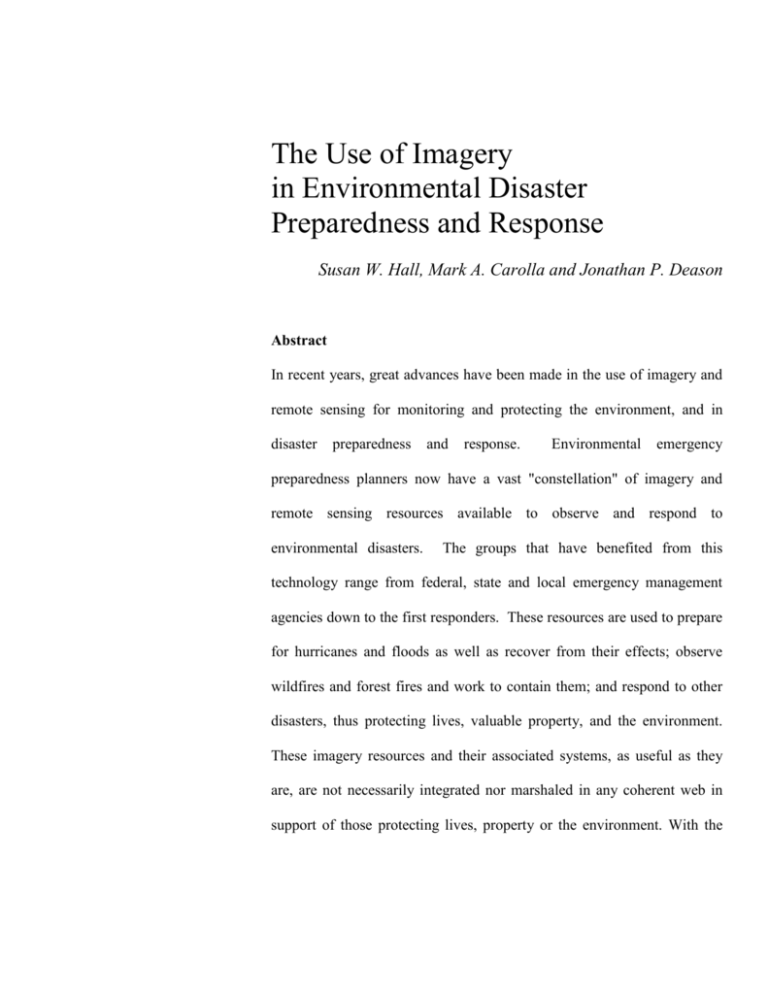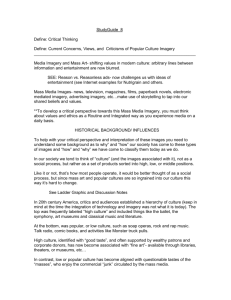The Use of Imagery in Environmental Disaster Preparedness and
advertisement

The Use of Imagery in Environmental Disaster Preparedness and Response Susan W. Hall, Mark A. Carolla and Jonathan P. Deason Abstract In recent years, great advances have been made in the use of imagery and remote sensing for monitoring and protecting the environment, and in disaster preparedness and response. Environmental emergency preparedness planners now have a vast "constellation" of imagery and remote sensing resources available to observe and respond to environmental disasters. The groups that have benefited from this technology range from federal, state and local emergency management agencies down to the first responders. These resources are used to prepare for hurricanes and floods as well as recover from their effects; observe wildfires and forest fires and work to contain them; and respond to other disasters, thus protecting lives, valuable property, and the environment. These imagery resources and their associated systems, as useful as they are, are not necessarily integrated nor marshaled in any coherent web in support of those protecting lives, property or the environment. With the new openness, declassification and commercial availability of highresolution imagery, remote-sensing capabilities now available to preparedness and response individuals range from satellite sensors to aircraft platforms. Introduction Overhead imagery, whether obtained from aircraft or commercial satellites, is particularly well suited to providing a rapid damage assessment in the wake of natural disasters. After a natural disaster strikes, national authorities must make rapid decisions about where to concentrate limited emergency relief assets in order to save the most lives and reestablish normalcy as quickly as possible. Just when it is needed most, the communications infrastructure may be badly damaged compounding the challenges a (local, regional, national, and international) government body faces as it seeks to assess the critical situation. Overhead imagery, when timely acquired and disseminated, can profoundly improve the authoritative governmental decision-makers’ position. Images from above, particularly when compared alongside images taken before the disaster occurred, can provide an immediate understanding of where infrastructure damage took place, can aid in the routing of relief efforts, and ultimately in prioritizing infrastructure repairs. Over the course of the past several years, the United States government has used imagery data obtained primarily from aircraft to survey the aftermath of natural disasters in the Western Hemisphere. This collection supported the recent hurricanes in Florida and in the Gulf Coast (See Figure 1) as well as in Central America and the entire Caribbean area to assist in preparedness and relief efforts for Hurricane Mitch and other disasters. These experiences have driven home the benefits of using overhead imagery for the purposes of disaster relief and have resulted in important applications of this predominantly military-utilized data collection process in the environmental emergency preparedness forum. This paper describes how overhead imagery data can be obtained, how it has been used in the past, and lessons learned, and provides points of contact for additional information.1 Modern geospatial information systems (GIS) provide software which, when integrated with imagery, can be used to enable analysts as well as relief workers to make new maps, provide planning graphics, and enhance other tools for disaster preparedness and relief. These GIS are 1 In the United States, two agencies within the Department of Defense have responsibility for adapting imagery and sensors to the task of preparing for and providing relief from disasters: The Defense Threat Reduction Agency (DTRA) and the National GeospatialIntelligence Agency (NGA). Both of these agencies contributed to this paper and the images that accompany it. commercially available and may be readily integrated with commercial imagery. Open Skies Treaty The Open Skies Treaty, signed in 1992 in Helsinki, was designed to strengthen its signatories’ abilities to prevent conflict and manage crises in situations in which a natural disaster affected one or more of the signatory nations’ regions. The treaty promotes openness and transparency in military activities through reciprocal, unarmed observation overflights. Currently, signatories include the United States, Canada and 30 other countries of Europe, the former Soviet Union and South America. The current Open Skies Treaty allows nations, with proper notification and escort, to fly over each other’s territories with imaging sensors on board. Although originally designed for purely cooperative monitoring measures, the preamble to the treaty states specifically that it envisions, “…the possible extension of the Open Skies regime into additional fields, such as the protection of the environment.” Aerial Platforms The United States has had recent experience using its OC-135B aircraft, based on the Boeing 707 design, as a platform for aerial observation of disaster areas. This aircraft is equipped with readily available and flexible commercial sensors including framing and panoramic cameras. It was developed specifically for use as the United States Open Skies Treaty platform. There are many other imagery-capable aircraft in the military and civilian inventories of nations in the western hemisphere. As one example, Brazil has developed the Embraer 145 remote-Sensing aircraft to be the surveillance aircraft of the Sistema de Vigilância da Amazônia (Amazon Surveillance System or SIVAM). It is a commuter class jet aircraft carrying a command-and-control system based on commercial off-theshelf (COTS) computers that may be used for a variety of both military and environmental surveillance and protection missions. Additionally, there are numerous commercial assets available that also are well suited for aerial observation. Commercial photographic-capable aircraft have already been used to carry out confidence and security building measure (CSBM) missions. Ecuador and Peru used a Cessna and a Learjet to map their border. And, in the United States, NGA has contracted a Learjet to carry out a variety of CSBM as well as environmental missions. Aerial Imagery of Damage Caused by Hurricane Mitch In early December 1998, a U.S. Air Force aircraft flew sorties over severely damaged areas in Central America immediately following the landfall of Hurricane Mitch (Figure 2). The crew, including representatives from DTRA and the United States Geological Survey (USGS), used both wet film and digital media to survey the stricken area to assess damage, to plan and prioritize response, and to perform scientific analysis. 2 Photographs and images were taken with several different commercially available optical cameras, including one vertically mounted framing camera (KS-87), one panoramic camera, one video camera, and handheld 35 mm cameras with both color and black and white film. Kodak Ektachrome color film was used for coastal regions because it provided a clear view of flood areas and the alterations to coral reefs more definitively than the black and white film. For maximum coverage, the crew flew at 25,000 feet (8000-9000 meters), which yielded resolution in the one-meter range. Both vertical and oblique photographs are available to interested parties using CD-ROMs and the Internet.3 Lessons Learned from Aerial Imagery during Hurricane Mitch One of the most important lessons learned from this experience is that aircraft offer a valuable capability no commercial satellite can provide – the ability to give government and disaster relief officials a realtime, birds-eye view of damaged areas so that decision makers can direct aid quickly and accurately. The experience also pointed out the value of 2 DTRA offered seats to government representatives from imaged countries to fly on board the aircraft but no one was able to take advantage of the opportunity due to various logistical factors such as timing. 3 For distribution information, the USGS web site can be consulted at http://www.usgs.gov. flexible sensor suites; different cameras – each with distinct advantages and disadvantages – can be optimized in response to dynamic weather and/or priorities. It also demonstrated that “wet” film is not always the best approach for timely distribution of imagery after flight because such imagery must be digitized and further modified so that images can be stitched together prior to analysis. This is a slow, labor intensive process that hampers timely distribution. Caribbean Pre-Disaster Surveys The Caribbean region bears the brunt of hurricanes each year and the countries within that region have expended considerable effort to prepare for them. In February 2000, many Caribbean nations cooperated with the United States Southern Command and DTRA to obtain predisaster imagery of the region. These images were acquired for use as a baseline so that, in the event of a hurricane or other natural disaster, a map of pre-disaster conditions would be available for comparison. After coordination was conducted and diplomatic clearances obtained, the United States Open Skies team operated aircraft out of Roosevelt Roads Naval Air Station, Puerto Rico, and covered the areas identified in Figure 3. 4 4 The DTRA crew, augmented by a French Haiti did not provide diplomatic clearance, so that country was not imaged. The Netherlands Antilles and Jamaica provided clearances, but could not be imaged due to aircraft mechanical problems. As this was a cooperative international process, when it government representative when flying over French territories, experimented with new technology and added digital equipment to their normal complement of cameras in an effort to improve the timelines of the products. They added “digital backs” leased from Lockheed Martin to the KS-87 vertical framing camera and developed and tested special software so the digital back camera could provide imagery annotation and a realtime display. The digital imagery worked out quite well, with quality levels at least comparable to wet film. The costs of development, testing, and leasing were more than offset by not having to develop film in the timeconsuming traditional manner. On the technical side, the software was a success. Determinations were made regarding optimum methods for recording, monitoring, and storage of digital imagery. For storage, DCRsi videotapes with very large capacity were used. After flight completion, it was found that, with sufficiently powerful computers and extra manpower, the data could be processed expeditiously. Commercial Satellites NGA also has found commercial satellite imagery to be useful in certain disaster preparedness and response applications. Commercial came to diplomatic clearances, most of the nations allowed release of the imagery to other Caribbean nations upon request. Those who withheld imagery release were not included in the flight plan. satellite imagery offers relatively high spatial resolutions with broad-area coverage. Several commercial satellites collect multispectral imagery (MSI) in addition to coincident panchromatic data. This can provide users with valuable information when trying to survey and assess natural disasters. Modern commercial satellites now have a broad range of sensors and improved resolution. They also are capable of a variety of analytical tasks related to the environment and disaster preparation and relief. Although satellites cannot dodge cloud cover as effectively as aircraft with commercial-type sensors, they do offer impressive imaging capabilities. Depending upon the commercial platform involved, tasking and turn-around can be accomplished in a matter of hours. Another benefit of commercial imagery involves the multiple bands of color that are available. The launch of Landsat-I in 1972, and subsequent launches of other commercial satellites with multispectral capabilities, provide a vast archive of earth imagery available for historical, or disaster baseline analysis. Over the years, many multispectral imagery applications have been developed. This has proved useful to analysts in that multiple band applications are well suited to the use of algorithms and digital image processing techniques for analysis. Multispectral GIS applications provide valuable tools in disaster preparedness and response. Commercially available panchromatic images also can be useful in identifying and assessing rail yards, street networks, and lines of communication both for disaster readiness and relief assessments. With both panchromatic and multispectral imagery, numerous environmental issues related to disaster relief can be analyzed. For example, oil can be seen leaking from ships’ hulls and the flow of spills monitored. Spectral imagery, in particular, can provide information on relative depths of nearshore channels, reefs, and underwater obstacles. This is of obvious utility in post-hurricane or flood damage assessment. However, it should be noted that various factors come into play with the use of commercial satellite imagery, including satellite orbits and collection window availability, as well as cost and processing issues. There are many commercial vendors who are both capable and experienced in the integration of GIS with commercial imagery. Contacts and Resources DTRA and NGA continue to discuss these concepts with international colleagues at the Center for Hemispheric Defense Studies and the Inter-American Defense College as well as with representatives from other defense and security institutions around the world. NGA has a wealth of information available on the applications of imagery and GIS on the Internet at its website: www.nga.mil. Additionally, those interested in the practical applications of confidence-and-security-building measures, cooperative monitoring, and arms control technology implementation in general can find useful information at the Defense Threat Reduction Agency’s website: www.dtra.mil. Conclusion Aerial and satellite overhead imagery is a tremendous asset when disaster strikes. It provides governmental and non-governmental organizations with timely and accurate assessments of infrastructure damage for the coordination and effective response for emergency equipment and teams, food supply, and engineering equipment for reparative efforts. The early stages of a natural disaster are the time when these resources are most needed and any delay in the ineffective deployment of these assets will likely result in increase loss of life. There is no “one-size-fits-all” for what kind of imagery is best. Digital imagery can be distributed very quickly when a reliable computer network system is available. When an adequate network is not available, the increased costs of digital imagery may not be worthwhile. As illustrated above, each type of “wet film” camera has its own advantages and disadvantages; the value of each must be carefully weighed against the factors for which it is used. For countries considering the use of imagery missions after a natural disaster, it is important to conduct as much advance coordination among respective governmental agencies and other organizations within the photographic imagery community to facilitate expeditious responses to imagery requests. Pre-disaster surveys, in addition to providing baselines for future comparisons, can act as dress rehearsals during which coordination details can be delineated. Susan W. Hall is the Director of the National Geospatial-Intelligence Agency (NGA) Support Team for the Department of Homeland Security (DHS). She supports the Agency in the execution of NGA resources assigned to DHS. Her responsibilities include numerous regional, issuedriven, and homeland security/defense requirements to include the war on terrorism, humanitarian and disaster operations, border and maritime security and support to the United States Secret Service mission. Ms. Hall began her DoD career with the Defense Mapping Agency in 1980 as a Cartographer. Her education includes a BA in Geography from the George Mason University and an MS in Information Management from the George Washington University. Her professional training includes the DoD Executive Leadership Demonstration Program, and the Inter-American Defense College Senior Service School. Mark A. Carolla is a Senior Imagery Analyst with NGA’s Office of Eurasia and Africa. His responsibilities include regional area analysis for studies related to these geographic areas. Mr. Carolla has extensive diplomatic and international relations experience as it relates to the application of geospatial-intelligence. Mr. Carolla began his DoD career with the Defense Intelligence Agency in 1977 as an Intelligence Analyst. He has held numerous analytic positions in DoD to include the On-Site Inspection Agency, the Defense Threat Reduction Agency and the National Geospatial-Intelligence Agency. His education includes a BA in History from Middlebury College and a MA in Foreign Affairs from the University of Virginia. His professional training includes the DoD Senior Executive Leadership Course and the Inter-American Defense College Senior Service School. Jonathan P. Deason is the Lead Professor of the Environmental and Energy Management program at the George Washington University in Washington, D.C. He previously was Director of the Office of Environmental Policy and Compliance at the U.S. Department of the Interior. Dr. Deason holds a BS in Engineering from the U.S. Military Academy, an MS in Environmental Engineering from the Johns Hopkins University, an MBA in Management form the Golden Gate University, and a PhD in Environmental Systems Engineering from the University of Virginia. He is the recipient of the Arthur S. Flemming Award, the Founder's Medal of the National Society of Professional Engineers, and an Executive Rank Award from the President of the United States. Figure 1 – Gulf Coast Satellite Image Figure 2 – Hurricane Mitch Image Figure 3 – Caribbean Surveys Mission April 2000 Disaster Preparedness Flight in Support of U.S Southern Southern Command DAY 6 NAS Roosevelt Roads DAY 11-2 DAY 5/7 DAY 4 DAY 3







